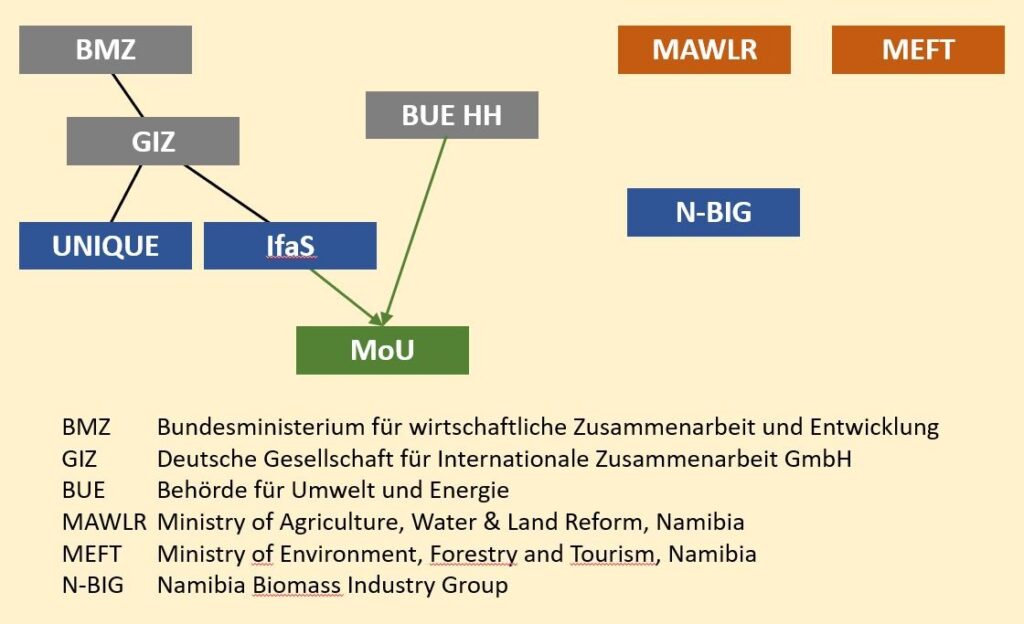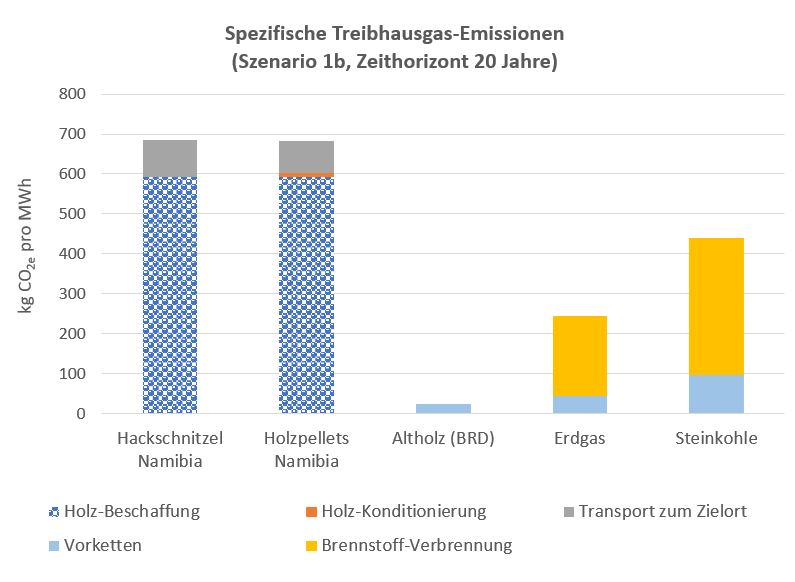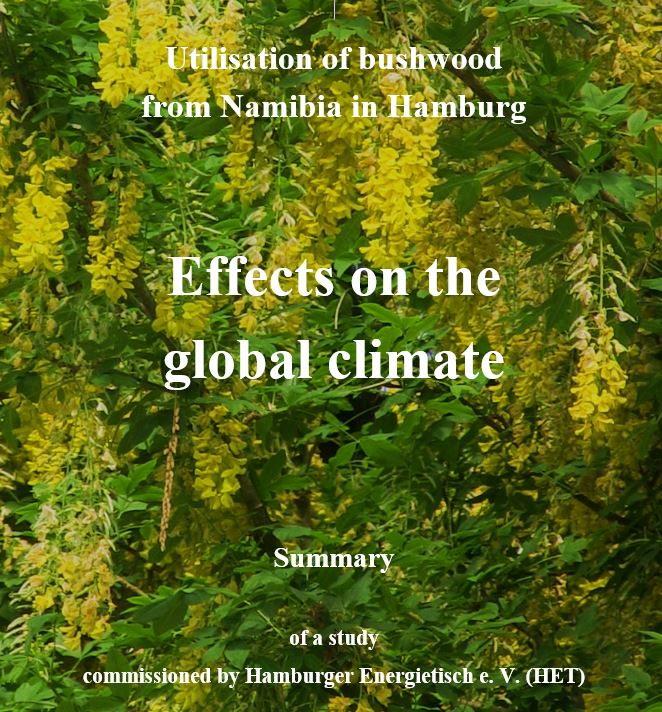Here as pdf-File
German actors sign a Memorandum of Understanding for biomass partnerships between Hamburg and Namibia
The Institut für angewandtes Stoffstrommanagement (IfaS) of the University of Applied Sciences Trier and the Hamburger Behörde für Umwelt und Energie (BUE) signed a Memorandum of Understanding (MoU) for biomass partnerships with Namibia on 12 May 2020. The district heating company Wärme Hamburg GmbH and the Hamburg University of Applied Sciences are also among the signatories. According to a press release by BUE, Hamburg and Namibia will examine the sustainable use of biomass from Namibia. The German Federal Government, the State of Namibia as well as development cooperation NGOs and the scientific community are said to have initiated this initiative.
The MoU provides for the formation of three working groups. BUE Staatsrat Pollmann: „Energy from Namibian biomass could help us to get out of coal more quickly when it comes to supplying district heating. The prequisite for this is that the social and ecological balance is right throughout the entire supply chain.“ A large part of the added value should take place in Namibia, he said. „As many local people as possible should benefit.“ A concluding interdisciplinary exchange oft the working groups is envisaged for July 2021.
GIZ’s „Use of bush biomass“ project will run from 2018 to 2021 with a budget of 10 million euros. A GIZ project „Support for bush clearance“ preceded this.
The project to transport intrusive bushwood from Namibia to Hamburg on a large scale in order to use it for district heating was proposed to Hamburg by the Deutsche Gesellschaft für Internationale Zusammenarbeit (GIZ) and IfaS in a dossier dated April 18, 2019. Thereupon, the replacement of hard coal by bushwood from Namibia at the Tiefstack combined-heat-and power (CHP) plant was discussed in a small circle. This cogeneration plant is to become coal-free by the end of 2030 at the latest. Other uses of bushwood in Hamburg were also considered, for example in a biorefinery.
According to the MoU, the use of bushwood from other countries should also be examined. In an IfaS presentation Cuba, Botswana, South Africa, Angola etc. were mentioned for replication.
In environmental circles in Hamburg the bushwood plans became known after the Hamburger Energietisch published the GIZ-IfaS dossier it had obtained. The media only reported on this after the signing of the Memorandum of Understanding.
In Namibia, the project had already been presented in expert circles several months before the MoU. The broader public in Namibia only became aware of it after the signing of the MoU. The late information release met with criticism.

Business Interests in Namibia
In a press release, the Namibia Biomass Industry Group (N-BiG), which was founded in December 2015 under the auspices of GIZ, added details about the start of the project: In September 2019 a delegation from Namibia visited Hamburg. The delegation was led by Ned Sibeya from the Namibian National Planning Commission and Josef Hailwa from the Forest Directorate and included representatives from government, industry and farmer associations, environmental NGOs and science.
N-BiG sees considerable market demand for woody biomass in existing and future market segments, both locally and internationally. A robust biomass supply chain would be required to meet the demands of large-scale consumers. Large consumers need an uninterrupted and reliable supply of biomass. Small and medium-sized enterprises would also benefit, as they would gain access to a new, locally sourced raw material with unlimited potential. For landowners, affordable harvesting on a contract basis would become increasingly accessible, which would have many advantages over other bush control techniques, N-BiG says.
Effects of bushwood use on the global climate
The reclamation of pasture land for livestock breeding or tourism, by removing or thinning out scrubland, is obviously a process that is subsumed under the term AFOLU in current greenhouse gas balances. AFOLU is the abbreviation for „Agriculture, Forestry and Other Land Use“. The Intergovernmental Panel on Climate Change (IPCC) has written a separate chapter 11 for this in its Fifth World Climate Report. According to this chapter, the AFOLU land use sector is responsible for almost a quarter of anthropogenic greenhouse gas emissions, which are mainly caused by deforestation and agricultural emissions from livestock, soil and nutrient management.
In the GIZ-IfaS dossier greenhouse gas emissions from land use changes are completely ignored. Greenhouse gases for the bushwood brought to Hamburg are limited here to truck, rail and ship transport. The dossier also assumes that the burning of the Namibian bushwood is climate-neutral, although the re-growth of the wood is prevented.
GIZ commissioned the forestry consultancy UNIQUE to prepare a report entitled „Greenhouse Gas Assessment of Bush Control and Biomass Utilization in Namibia“, which has been available in a long and a short version since December 2019. The report evaluates six scenarios of bushwood utilisation. In scenario 1, greenhouse gases are saved to a considerable extent, although the wood is burned without regrowth and methane emitting ruminants are to be increasingly used in the cleared area.
Since the UNIQUE report will also form the basis of the planned use of bushwood in Hamburg, the Hamburger Energietisch (HET) commissioned its own expert opinion to evaluate the greenhouse gas emissions. This HET report has been available since mid-June 2020 as a full text and in a German and an English summary.
The results of this report differ very much from those of the UNIQUE report. According to the scenario, in the worst case the greenhouse gas emissions are far higher than those of hard coal (figure), in the best case they are not lower than those of fossil natural gas as an energy source for use in Hamburg’s district heating system.
Bush thinning with subsequent use for livestock breeding and for direct energetic use of the wood after transport to Hamburg results in greenhouse gas emissions from wood combustion, methane emissions from additionally kept ruminants and losses of organic carbon, of which more is present in the soil under bush cover than in the soil under grazed grassland.

The HET report therefore strongly advises against the use of Namibian bushwood in Hamburg. This is because the new combined heat and power plants that are to be built to replace Hamburg’s hard coal-fired cogeneration plants in the current decade are likely to be in operation beyond 2050. However, Hamburg wants to achieve climate neutrality by 2050 at the latest.
Should Hamburg nevertheless agree to the transcontinental timber transfer for political reasons, the report states that more than 50 million trees would have to be planted in Namibia as soon as possible to compensate for the climate damage caused by the use of bushwood in the Tiefstack cogeneration plant. Compensation would also have to be provided for the extraction of minerals from Namibia’s barren soils that are necessary for plant growth.
A material use of bushwood in southern Africa has a much better greenhouse gas balance than burning the wood. The planned use of bushwood in Namibia to generate electricity is also better than exporting wood, because it can displace coal-based electricity. However, this only applies to a limited capacity, as solar power is unbeatably cheap in Namibia’s climate.
Reasons for the differences in the greenhouse gas balances
The HET report assesses the greenhouse gas emissions from bushwood use in several points significantly differently than the UNIQUE report.
- UNIQUE assumes that the soil of a restored savannah (grassland) stores more organic carbon than the soil under a scrubland. However, this assumption is based on outdated, little secured data. Recent research over the last two decades has almost consistently shown that in arid areas, considerably more organic carbon is stored under bushes than under grassland. Thus, for UNIQUE a scrubland is a CO2 sink, whereas for the HET report it is a rather strong CO2 source.
- The reclaimed grassland should preferably be used for an expansion of livestock breeding. During their digestive process, ruminants release methane, a climate gas that is almost a hundred times more potent than CO2 over a period of about 20 years. The HET expert opinion calculates with a time horizon of 20 years, since it is during this period that it will be decided whether dangerous tipping points for the development of the climate can still be avoided. The UNIQUE expert opinion calculates with a time horizon of 100 years and thus strongly underestimates the effect of methane in the next 20 years.
- The UNIQUE report is limited to a timber harvest in Namibia. The HET report, on the other hand, also takes into account timber transport to Hamburg.
- The UNIQUE report does not even consider one important aspect. It is also not to be seen in the comparison of the emissions of different greenhouse gases shown above. If bushwood is continuously harvested over 20 years, delivered to Hamburg and burned, then direct CO2 emissions result from the transport and combustion. However, the CO2 source soil can remain active for decades after combustion. Methane emissions from ruminants also continue. In effect, this means that the total greenhouse gas emissions caused by burning bushwood will increase over time, although the greenhouse gases caused by Hamburg must decrease, as Hamburg wants to become climate neutral by 2050.
The re-growth of bushwood on the de-bushed areas in Namibia is to be prevented. Now some people argue that the bushwood removed is growing back at the same time in other areas of Namibia. According to the plans of the GIZ, however, twice as much bushwood is to be harvested by 2030 as is allegedly growing back at the same time. Until Hamburg is ready to burn bushwood in the Tiefstack power plant, there will be no re-growth for the burned wood in Namibia. Moreover, compensation of this kind would first have to be reserved for Namibia itself.

